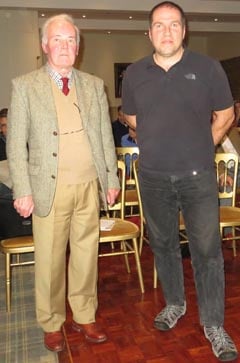There were some stone horror stories for The Men of the Stones* at their meeting last month (November) when stone consultant Barry Hunt, a regular contributor to Natural Stone Specialist magazine, was the guest speaker.
“Pieces of stone falling off buildings is far more common than you think,” he told his audience. “No-one’s inspecting and maintaining buildings.”
Mercifully, most of it did not hit anyone, although he said it was far too common that it did hit people.
Signs of fallen masonry quickly disappear. When a piece of stone hits the ground it usually shatters and the pieces of stone and dust are quickly dispersed, especially in cities as people walk over them and street cleaners sweep away the evidence.
One of the problems identified by Barry is building ‘creep’. Structures erected in the 1960s are settling, which is compressing stone cladding and leading to its failure. It is, he said, a common problem that nobody is addressing.
He illustrated the problems he has encountered as a stone consultant and expert witness with pictures he took of the structures he has been called in to report on.
He often carries out his surveys hanging from a rope because, as he explained, he is qualified in industrial roped access, which gets him up close and personal with the stone – “tasting it can tell you a lot,” he said.
He spoke of multi-million pound disputes he had been asked to comment on and to act as an expert witness in court cases where the stone had failed in some way, although he said when stone failed it was often because it had not been designed properly or fixed properly.
He said changes in the way buildings are used could lead to problems and cited lighthouses.
Usually built of granite, they had stood in the harshest of conditions, sometimes for centuries, without any problems, but when lighthouse keepers stopped living in them in the late 20th century, salt migration had become evident on the interior walls.
Barry concluded that what had led to the discolouration of the walls was the absence of heating. Once they were abandoned there was no more interior heating. It had been the heating regulating the interior conditions that had prevented the salt migration for most of the life of the lighthouses.
He spoke of the problems of pyrites in slate, especially imported slate, which had led to delamination and the failure of roofs.
He warned against polished dark stone floors, because they would become lighter as they became scratched with use. As there would be more scratches where the stone was most used, lighter pathways could appear. There were several properties in London where the dark floors were being re-polished every month.
He criticised test regimes carried out on stone before it is used to clad buildings, saying the tests were often more about satisfying building regulations than finding out anything useful about the stone. “It’s very, very difficult to unravel test results,” said Barry.
He believed he could tell a lot about a stone by looking at it through his microscope, especially at a magnification of 3,000 times, which is about as great as can be achieved with an optical microscope.
He also said there was no point in most design teams visiting quarries to see the stones they intend to use. Barry: “They stand at the top of a quarry and don’t know what they’re looking at. It’s just a waste of money.”
He said that stone provided the ideal finish for a building and “I believe we can meet the challenges of using stone given the right advice – but there aren’t enough of us out there to give the right advice.”
*The Men of the Stones was established after World War II by the people of Stamford, a town in Lincolnshire largely built of Barnack and Clipsham with Collyweston roofing, to address the problem of a shortage of skills to maintain their properties. Many in the stone industry had joined the forces during the war and did not return to the industry afterwards.

